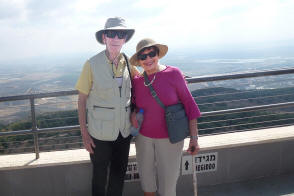Tuesday, September 10. We were up at 6.We put our suitcases out in the hall before going down
to the dining room for a buffet breakfast at 6:45. The bus left 8:15, heading north along the coast
to Caesarea, just 30 minutes away. This was once the ancient city of Caesarea Maritima, built
from scratch by Herod the Great about 25-13 B.C. and named to honor the occupying Romans
who had helped him gain his crown. The ancient city was a magnificent engineering feat with a
large artificial harbor, making it the seaport and the principal city in the entire area. The Romans
made it their administrative capital, as did the Byzantines after them.
Since then, the city has had its ups and downs. After the Muslim conquest of the Holy Land (640
A.D.), the city degraded into a small village. Under the Crusaders it once again became a major
port and a fortified city, but it declined again when the Crusaders were driven out. It was just a
small Arab fishing village in 1948 when it was captured by the Israelis. In 1952, the modern
Jewish town of Caesarea was established near the old ruins.
Shanee had a folding "time-line" chart she used
frequently throughout the trip to help us understand the many different
periods of history in the Holy Land. We spent about half an hour there
exploring the reconstructed Roman theater and the nearby ruins of Herod’s palace. That was only
a small portion of the excavated area.

Sitting in restored Roman theater |

Shanee with time line |

Ruins of Herod's Palace
|
The layering of settlements on popular sites makes exploring history particularly problematic in
the Holy Land. Caesarea being a relatively recent development, and on a fresh site, is fairly
straightforward. Many other sites we were to visit would have multiple layers going back
thousands of years.
Our next stop, at Mount Carmel, about 25 miles to the north, was a
different kind of example of the frequent
leaps in time we encountered on this trip. Mount Carmel has been considered a holy place from
ancient times. It is the reputed site of the Prophet Elijah’s victory over the priests of Baal in the
9th Century B.C. The Carmelite religious order was founded here about 1200, and its Stella
Manis Monastery (1836) occupies the site.

Entrance to Monastery |

Elijah statue |
We arrived there about 10:00 and walked up to a patio of the
monastery with great views in three directions. Of
course, there were no ruins or other physical evidence of the Biblical event, only a tall statue in
the courtyard depicting Elijah as he defeats a Baal priest. Our group then assembled in the garden
for a brief service before reboarding the bus at 11:10.

View toward Mediterranean |

Meggido view behind us |

Pastor Keller leads srvice |
We stopped nearby for a very heavy lunch. [Tour information indicated that we would be on our
own for lunch, but that was rarely possible because the bus always stopped in a restaurant parking
lot, leaving us no choice as to where too eat.]

Wedding Church |
We reached our next stop at Cana about 1:00. Over
the years, nearby Nazareth has grow so large that it seems to have
enveloped Cana. We were disappointed that our tour did not include a
stop at the Holy Family sites in Nazareth since we were so close.
Instead we spent half an hour visiting the Wedding Church in Cana
(1881, but renovated in 1999). Although it was built on the site of
a 14th Century synagogue, there is no known connection to Jesus or his first miracle.
A large stone water jug
on display, promotes the impression that maybe there was. In any
event, this Franciscan church is very populat for weddings.

Wedding Church interior |

Exposed synagogue ruins |

Stone water jug |

Entering modern Capernaum |
We drove on to Capernaum, about 25 miles to the east, arriving at 2:15. By now it was a very hot
day, about 100 degrees. This fishing village dates to about 100 B.C. after the Hasmonean Dynasty
of Judea extended its rule to the north to include Galilee. After Jesus began his public life, he
moved from Nazareth to Capernaum and collected five of his apostles from the area.
Capernaum is on the north
shore of the Sea of Galilee, only a few miles from the Golan Heights, the hills running north from the
east side of Sea of Galilee to the Lebanese border. Most of Golan has been occupied by Israel
since 1967, and in March 2019 the U.S. recognized its annexation.
In Kfar Nahum National Park, just outside the present
town of Caphernaum, there are ruins of the fishing village that dates from the time of
Jesus, including the site (foundations) of the synagogue of that time and of
Peter's house. However, we did not visit the Park. We took a brief stroll
along the Sea of Galilee in the modern town,. The way was lined with old
stone blocks, columns and capitals taken from the original village
and placed here without context. Then Pastor Keller held held a
short service in a beautiful wooded area.